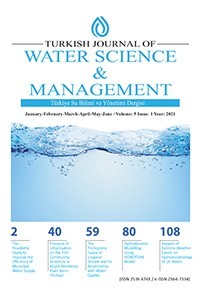Planning of Sectoral Water Allocation: A case study of Seyhan River Basin
Planning of Sectoral Water Allocation: A case study of Seyhan River Basin
Water resources management, water potential sectoral water demands, sectoral subbasin, water allocation,
___
- DSI (2014). Master Plan Report for Seyhan River Basin. Devlet Su İşleri Genel Müdürlüğü.
- Food and Agriculture Organization of the United Nations (1998). Crop evapotranspiration Guidelines for computing crop water requirements (FAO Irrigation and Drainage paper 56.)
- Huber-Lee, A., D. Yates, D. Purkey, W. Yu, B. Runkle, (2003). Water, climate, food, and environment in the Sacramento Basin — contribution to ADAPT: Adaptation strategies to changing environment. Stockholm Environment Institute, Boston, MA, USA.
- Intergovernmental Panel on Climate Change (2014). Climate Change 2014: The Physical Science Basis. Contribution of Working Group I to the Fifth Assessment Report of the Intergovernmental Panel on Climate Change, (Cambridge University Press).
- McKee, T.B., N.J. Doesken & J. Kleist, (1993). The relationship of drought frequency and duration to time scale. Proceedings of the Eighth Conference on Applied Climatology, California, 1993. Boston, American Meteorological Society, pp. 179–184.)
- Psomas, A., Y. Panagopoulos, D. Konsta & M. Mimikou, (2016) Designing water efficiency measures in a catchment in Greece using WEAP and SWAT models (2nd EWAS International Conference).
- Raes, D., Mallants, D., & Song, Z., (1996). Rainbow: A software package for Analyzing hydrologic data. (Hydraulic engineering software VI. Southampton, Boston, Mass., Computational Mechanics publications, pp. 525-34.)
- Sánchez, R. & G. Schmidt., (2012). Environmental flows in the EU.
- Suryawanshi, R. A. & A. J. Shirke, (2014). Watershed Management of Subernarekha River Basin using WEAP, (International Journal of Recent Trends in Science and Technology, Vol. 12, No. 1, pp. 156-163.)
- SYGM (2016). Sectorale Water Allocation Plan for Seyhan River Basin. Orman ve Su İşleri Bakanlığı, Su Yönetimi Genel Müdürlüğü.
- SYGM, (2016). The Project of Impacts of Climate Change on Water Resources. Orman ve Su İşleri Bakanlığı, Su Yönetimi Genel Müdürlüğü.
- SPSS Statistics Base 17.0 User’s Guide (2007). USA, pp. 640.
- Tena B. A., Srinivasa Rao G. V. R., Abbulu Y., (2015). WEAP Modeling of Surface Water Resources Allocation in Didessa Subbasin, West Ethiopia, Sustainable Water Resources Management.
- Tennant, D.L., (1976). Instream flow regimens for flush, wildlife, recreation and related environment resources (Fisheries, Volume 1, 1976 - Issue 4).
- World Meteorological Organization (2012). Standardized Precipitation Index, User Guide.
- ISSN: 2536-474X
- Başlangıç: 2017
- Yayıncı: Tarım ve Orman Bakanlığı Su Yönetimi Genel Müdürlüğü
Fransa’da Taşkın Riski Yönetiminde Kurumsal Çerçeve ve Türkiye İçin Öneriler
Optimization and Modelling of Pressurized Irrigation Networks
Flash Flooding and Green Stormwater Infrastructure in Philadelphia: Areas for Further Improvement
Identification of Specific Pollutants and Derivation of Environmental Quality Standards in Turkey
Aybala KOÇ ORHON, Esra ŞILTU, Sibel Mine GÜÇVER, Yakup KARAASLAN
Planning of Sectoral Water Allocation: A case study of Seyhan River Basin
